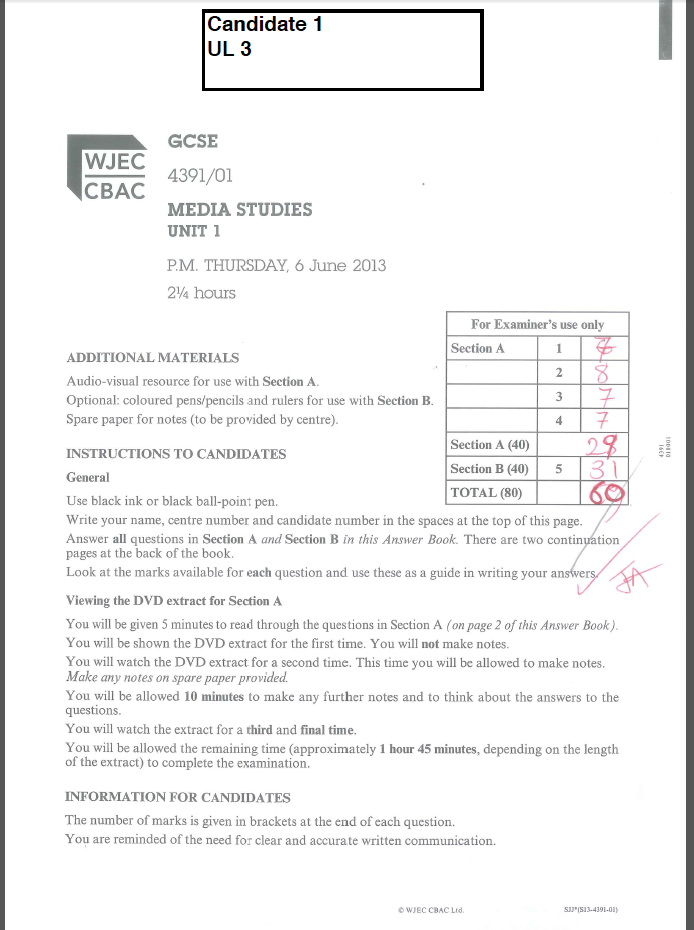You will take a look at exemplar exam work and evaluate it using the WJEC mark scheme.
| Section A: Thinking about the media - Investigating Four questions: candidates respond to stimulus material chosen from a topic set by WJEC. This section will also assess the way the contemporary media is convergent. Section B: Thinking about the media - Planning A series of tasks: candidates demonstrate planning and creative skills through a series of creative tasks which demonstrates knowledge of the convergent nature of the contemporary media. ____________________________________________________________________________ 2.2 The Media Studies framework The Media Studies framework will be used to explore all topics. It is based on:
texts (genre, narrative and representation issues)
organisations (marketing and promotional strategies, regulation and control issues and intrusion & privacy) and
audiences and users.
Media Texts: Genre, Narrative and Representation
generic features, conventions and iconography
principles of repetition and variation of a repertoire of elements
hybridity
intertextuality
genres – relationship between organisational and audience/user needs.
narrative construction and the role of editing in creating narratives (to include different types of montage)
implied narratives – visual organisation, hierarchies and compositional codes
narrative structures (based for example on equilibrium, disequilibrium and restoration of equilibrium; binary oppositions and their resolution; open & closed narratives; interactive narratives; linear and non-linear narratives; multi-stranded or flexi-narratives)
character functions within narratives
settings and locations in which narratives take place.
what makes representations - images plus points of view about them
the processes of 're-presenting' mediated versions of the 'real' world
stereotypes and representations - processes of categorisation, identification and recognition
the way people and groups of people are represented in the media - in terms of gender, ethnicity, cultural diversity, age and nation
the way events and issues are represented in the media. For media organisations, candidates study the ways in which media organisations create, sustain and expand their markets and the way they are regulated and controlled. They will also ask questions about personal, social and ethical dimensions in an increasingly convergent media world. (a) Marketing and Promotion For marketing and promotion, candidates study through their investigation and production work: the ways in which media organisations (such as film organisations, television channels, radio stations, newspapers, magazines, websites, social networks and individuals self-promoting) market, promote and brand themselves in a commercially competitive environment.
competition
use of stars/celebrities in marketing
cross-media campaigns
schedules and ratings
audience/user research and targeting
distribution strategies. For regulation and control, candidates study through their investigation and production work:
how different types of media are regulated and controlled
the reasons for media regulation and control and the problems of regulating within an increasingly global media environment
the way individuals can manage their own media. (c) Personal, Social and Ethical Dimensions For Personal, Social and Ethical Dimensions, candidates study through their investigation and production work:
conflicts between individual freedoms and media organisations
the personal, social and ethical dimensions of online environments. For media audiences/users, candidates will study: issues raised by the media for a range of audiences and users, including fans, both in terms of audience/user engagement and audience/user response and interpretation.
This is likely to involve consideration of:
ways of categorising audiences/users and audience/user composition
organisational issues such as how audiences are targeted, appealed to, created
audience/user response issues such as everyday uses and pleasures together with the different ways audiences and users interpret and interact with a variety of media. |
Continue with Coco Chanel task: Use the guidelines given to analyse the TV ad.



No comments:
Post a Comment